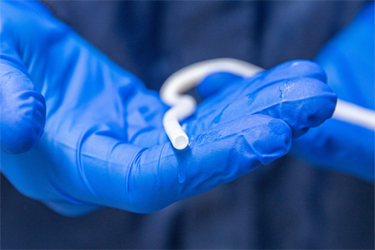Regenerating The Vasculature With Bioengineered Human Tissue

By Matthew Pillar, Editor, Bioprocess Online

Long before she founded Humacyte, Laura E. Niklason, M.D., Ph.D. spent many long hours practicing medicine in an ICU, where she watched helplessly as otherwise healthy patients succumbed to morbidities associated with the vasculature. Kidney disease, trauma, peripheral arterial disease, and congenital birth defects are just a few of the unmet medical needs she felt called to address. When she began the research that would ultimately lead to the launch of Humacyte in 2004, her premise was simple: countless lives could be sustained if science could grow human blood vessels in a lab.
By the time Chief Operating Officer Heather Prichard, Ph.D. joined Humacyte in 2008, the company had its sights set on solving two problems. First, it knew creating an autologous product from cells derived from specific patients would limit its reach and impact. Trauma patients, for instance, don’t have the luxury of the time it takes for scientists to extract their cells and grow them a new femoral artery in a lab. To address patient needs, the company would have to pursue an allogeneic strategy. That paradigm presented challenge number two. To make an impact, the vessels Humacyte develops would have to be accessible, meaning they would need to be produced in large volume and be shelf stable.
Manufacturing Bioengineered Blood Vessels At Scale

Then, Humacyte built an 80,000 square-foot modular manufacturing facility to accommodate the scale of its intentions. That facility is outfitted with purpose-built equipment that the company’s scientists and engineers designed and fabricated in-house. The company’s intellectual property is protected by trade secret. The proprietary manufacturing process begins with a polymer mesh that serves as a scaffold on which Humacyte can grow blood vessels in various shapes, lengths, and diameters. “That mesh defines the shape of the tissue we want to grow. It’s constructed of the same polymer used in biodegradable sutures,” Dr. Prichard explains.
During the growth process, Humacyte saturates the polymer mesh with cells and nutrient-rich media. It then sends biochemical signals, proteins and amino acids into the cells, which results in those cells building all the proteins, such as collagen, found in normal human blood vessels. All the while, the vessels are mechanically stimulated, or “pulsed,” as they grow. The culture process takes about two months, during which the polymer mesh degrades away. “At the end of the growth process, we have a strong blood vessel that still possesses the cells that we grew it from,” says Dr. Prichard.
To reduce the likelihood of immune rejection, Humacyte then removes the remaining origin cells, leaving a blood vessel that can be implanted into any patient. The vessel is then packaged and ready for shipment. Dr. Prichard says the vessels have an 18-month shelf life under refrigeration.
At present, Humacyte is operating 8 manufacturing lines capable of producing 8,000 vessels per year. Dr. Prichard says the company is prepared to scale that to 40,000 per year in its existing space. With two active Phase 3 trials underway in trauma and arteriovenous access, the likelihood of that expansion becoming necessary grows stronger by the day.
Next Project: Improving Treatments For Type 1 Diabetes
In addition to its Phase 3 trials, Humacyte is conducting a Phase 2 peripheral arterial disease trial and working on preclinical programs in pediatric heart disease, coronary artery bypass graft surgery, and Type 1 Diabetes. That latter program is one that’s near and dear to Dr. Prichard. “My dad is a Type 1 Diabetic,” she explains. “When he was diagnosed 50 years ago, he was told there would be a cure in 10 years. Here we are 50 years later, and he’s still insulin dependent.”
“As we were watching our clinical trials, [460 patients have been implanted with Humacyte products to date], we began thinking about implanting our product into position for dialysis access,” says Dr. Prichard. “Our product has high blood flow. One of the reasons cellular therapies die is that the cells don't get enough blood, which deprives them of the oxygen and nutrients they need to live. So, our concept for delivering cellular therapeutics to patients is to take our current blood vessel product and coat the outside of it with islets. Once implanted in an outpatient procedure, our blood vessel diffuses oxygen and nutrients to the islet cells. The islet cells can sense blood glucose and secrete insulin into the blood.” In preclinical rat studies, Humacyte’s BioVascular Pancreas, as it’s been dubbed, has demonstrated an ability to control blood glucose for a number of months. “It’s early-stage work, but we’re figuring out how to leverage our blood vessel to deliver cellular therapeutics,” says Dr. Prichard.
Tune in to episode 78 of the Business of Biotech podcast to learn how Humacyte is navigating interactions with FDA’s Center for Biologics Evaluation and Research (CBER), the support the company receives from public partnerships including the Department of Defense, which is keenly interested in the company’s technology to address trauma on the battlefield, and a whole lot more from Dr. Prichard.
